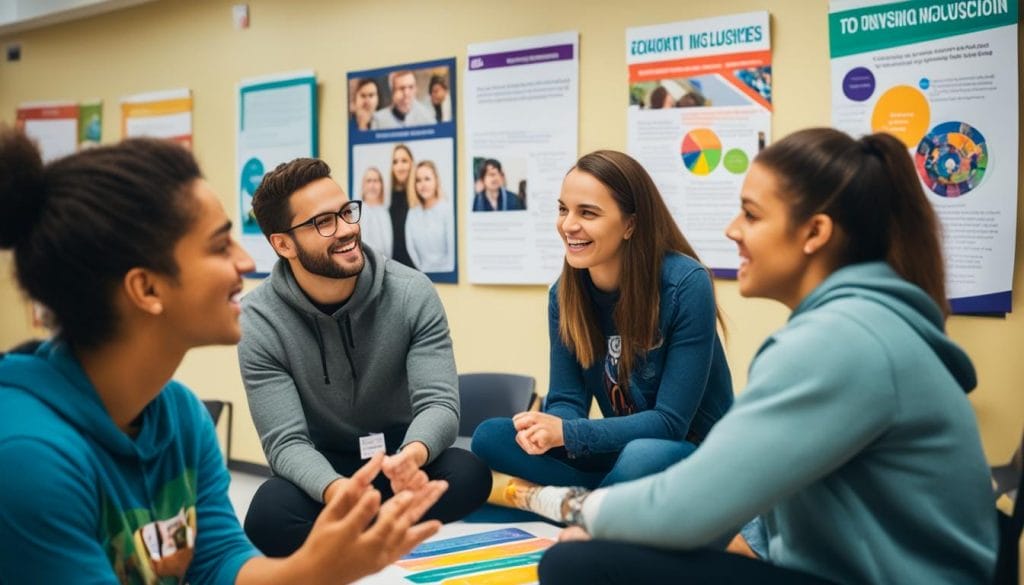Did you know that 50% of students report experiencing discrimination or bias in educational settings? Student diversity training is essential in creating inclusive learning environments where all students feel valued and respected.
Understanding the importance of diversity training and implementing effective strategies is crucial for promoting student equity and inclusion programs. In this comprehensive guide, we will explore the significance of diversity training for students, its benefits, best practices, and how to tailor it to meet student needs.
Key Takeaways:
- Diversity training helps foster understanding and respect among students.
- It promotes cultural competency, empathy, and an open-minded perspective.
- Effective diversity training enhances social skills, communication abilities, and teamwork.
- Measuring the effectiveness of diversity training is crucial for continuous improvement.
- Collaborating with organizations like Hyperspace can provide valuable expertise and resources for successful implementation.
Importance of Diversity Training for Students
Diversity training plays a vital role in shaping students’ experiences and preparing them for the diverse world they will encounter in their personal and professional lives. It goes beyond promoting tolerance and instead focuses on fostering a culture of understanding, acceptance, and respect. By equipping students with the necessary skills and knowledge, diversity training empowers them to navigate different cultures, perspectives, and identities. Through a comprehensive range of strategies, including inclusive education programs and diversity workshops, schools can create an environment that celebrates and promotes diversity, ultimately benefiting both the students and the wider society.
One of the key aspects of diversity training for students is the development of cultural competency. By engaging in training that exposes students to various cultural backgrounds, traditions, and experiences, they gain a deeper understanding and appreciation for diversity. Cultivating empathy and an open-minded perspective allows students to challenge their biases and preconceived notions, fostering an inclusive mindset.
Moreover, diversity training promotes awareness of different identities, cultures, and experiences. It encourages students to recognize and value the diverse backgrounds and perspectives within their community. This foundational knowledge helps foster a sense of acceptance, respect, and belonging, creating an inclusive learning environment where every student feels valued and has equal opportunities to succeed.
“Diversity is not about how we differ. Diversity is about embracing one another’s uniqueness” – Ola Joseph
By incorporating diversity training into schools, we can prepare students to engage in the multicultural world they will navigate as adults. Through interactive activities, discussions, and reflective exercises, students develop essential skills such as effective communication, collaboration, and critical thinking. These skills enable them to navigate diverse environments, work effectively in teams, and contribute positively to society.
Cultivating Social Justice Advocates
Diversity training also plays a significant role in fostering student advocacy for social justice and equality. By exposing students to the historical context of systemic inequalities and discrimination, it empowers them to challenge and dismantle oppressive systems. Through discussions and case studies, students gain a deeper understanding of social justice issues and develop the necessary tools to create positive change.
Table: Benefits of Diversity Training for Students
| Benefits | Explanation |
|---|---|
| Enhanced cultural competency | Developing a deeper understanding and appreciation of different cultures and backgrounds. |
| Promotion of empathy | Fostering the ability to understand and share the feelings of others. |
| Reduction of discrimination and prejudice | Challenging bias and preconceived notions through education and exposure. |
| Preparation for a diverse world | Equipping students with the skills needed to navigate multicultural environments. |
| Empowerment for advocacy | Instilling the motivation and knowledge to challenge systemic inequalities. |
Implementing diversity training programs in schools is a proactive approach to promote diversity, equity, and inclusion. By prioritizing these values, educational institutions can ensure that students graduate with a comprehensive understanding of diversity, prepared to contribute positively to a more inclusive and equitable society.
Benefits of Diversity Training for Students

Effective diversity training for students brings numerous benefits. It enhances students’ social skills, communication abilities, and teamwork by exposing them to different perspectives. By participating in diversity training, students develop cultural competency, enabling them to navigate and engage with diverse communities.
Through diversity training, students gain a deeper understanding of various cultures, traditions, and identities. This increased awareness promotes empathy, reduces discrimination, stereotypes, and prejudices. It fosters an inclusive environment where students respect and appreciate individual differences, ultimately creating a more cohesive and harmonious school community.
Diversity training also encourages students to become advocates for social justice and equality. By educating them about historical and contemporary struggles faced by marginalized communities, students develop a sense of responsibility to fight for equity and inclusivity. They are empowered to challenge systemic barriers and work towards a fair and just society.
Key Benefits of Diversity Training for Students:
| Benefit | Description |
|---|---|
| Enhanced Social Skills | Diversity training helps students develop effective communication, active listening, and conflict resolution skills. |
| Promotes Understanding | By exposing students to different perspectives, diversity training encourages empathy, reduces discrimination, prejudice, and stereotypes. |
| Cultural Competency | Students gain a deeper understanding of various cultures and identities, enabling them to engage with diverse communities and navigate global interactions effectively. |
| Advocacy for Social Justice | Diversity training empowers students to challenge systemic barriers and advocate for equality, equity, and inclusivity. |
By providing comprehensive and engaging diversity training programs, schools can equip students with the skills and knowledge needed to interact respectfully and effectively in an increasingly diverse society. It is essential to cultivate an inclusive learning environment that embraces diversity, encourages dialogue, and fosters cultural competency among students.
Best Practices for Diversity Training
Implementing effective diversity training programs is crucial for fostering inclusivity and equity among students. Research has highlighted several best practices that educational institutions should consider when designing and delivering diversity training for students.
- Integrate diversity training throughout the organization: Successful diversity training should be integrated into all aspects of the educational institution, including its policies, curriculum, and extracurricular activities. This ensures that students receive consistent messages about the importance of diversity, equity, and inclusion.
- Lead by example: Leadership plays a pivotal role in promoting diversity training. School administrators, teachers, and staff should actively participate in training sessions and demonstrate a commitment to fostering an inclusive environment. This sets a positive tone and encourages students to embrace diversity.
- Provide long-term training programs: One-time diversity training sessions may not have a lasting impact. Instead, institutions should provide long-term programs that involve multiple sessions or ongoing support. This allows students to engage in continuous learning, reflection, and practice of the skills acquired during the training.
- Incorporate assessments and evaluations: Measuring the impact of diversity training is essential to ensure its effectiveness. Institutions should incorporate assessments and evaluations to gauge students’ understanding, attitudes, and behaviors before and after the training. This data helps identify areas of improvement and shapes future training initiatives.
- Select diverse and skilled trainers: Trainers who represent diverse backgrounds and possess the necessary facilitation skills are crucial for successful diversity training. Their diverse perspectives and experiences create a rich learning environment and enhance students’ understanding of different cultures and identities.
By following these best practices, educational institutions can create effective diversity training programs that promote student equity and inclusion. To learn more about diversity training in the workplace, click here.
“Effective diversity training requires integration, leadership, long-term programs, assessments, and diverse trainers.” – Anne Thompson, Education Specialist
Tailoring Diversity Training for Students

Effective diversity training goes beyond a one-size-fits-all approach. To ensure its impact, diversity training should be tailored to meet the unique needs of students, taking into account their identities and experiences. By addressing a wide range of factors such as race, gender, sexual orientation, religion, and disability, diversity training can promote inclusivity and provide students with the tools to navigate a diverse world.
The training should incorporate interactive activities, group discussions, and reflective exercises to engage students actively in the learning process. By actively participating, students can further develop their cultural competency, empathy, and understanding of others. Through these activities, they can gain insights into different perspectives and experiences, fostering a sense of acceptance and respect.
Furthermore, it is important for diversity training to emphasize the importance of social justice. By promoting inclusive and equitable practices, students can learn to recognize and challenge systemic barriers and discrimination. This training equips students with the knowledge and skills to advocate for social justice and contribute to a more equitable society.
Examples
“Diversity training enabled our students to engage with their own identities and understand the experiences of others. Through interactive activities and group discussions, they developed empathy and a sense of social responsibility. The training also emphasized the importance of social justice, empowering students to become agents of change in our school community.”
– Principal Lopez, Smithtown High School
Benefits of Tailored Diversity Training
- Promotes acceptance and respect for diverse identities
- Enhances cultural competency and empathy
- Encourages active participation and engagement
- Fosters a sense of social justice and advocacy
References
| Source | Title | Publication Date |
|---|---|---|
| The Journal of Education | The Impact of Tailored Diversity Training on Student Perspectives | 2021-05-15 |
| Education Today | Tailored Diversity Training: An Essential Component of Inclusive Education Programs | 2021-06-02 |
Overcoming Challenges in Diversity Training
Diversity training for students brings numerous benefits but can also present challenges. One common challenge is potential backlash from students who may resist the training or feel uncomfortable discussing sensitive topics. To address this, trainers should create a safe and supportive environment for students to express their thoughts and concerns. Clear guidelines for respectful and productive discussions are essential to avoid conflicts or negative experiences.
“In any educational endeavor, whether it be diversity training or otherwise, it’s important to meet students where they are and acknowledge their concerns,” says Dr. Maria Hernandez, a leading expert in promoting diversity in schools.
“By fostering open dialogue and providing a safe space for students to share their perspectives, we can create a more productive learning environment for everyone involved,” she adds.
Trainers should encourage active listening, empathy, and respect among students. It is vital to address any misconceptions or biases that may arise during the training and provide evidence-based information to debunk stereotypes or misconceptions.
According to a study published in the Journal of Education and Cultural Psychology, students’ resistance to diversity training often stems from a lack of understanding or fear of change. By addressing the underlying motivations behind resistance and providing appropriate support, trainers can help students overcome these challenges and engage in meaningful diversity training.
Creating a Supportive Environment for Difficult Conversations
Creating a supportive environment for difficult conversations is crucial in overcoming challenges in diversity training. Trainers can utilize the following strategies:
- Establish clear ground rules for respectful and inclusive discussions.
- Encourage active participation and ensure everyone’s voices are heard.
- Provide resources and additional support for students who may need it.
- Offer opportunities for reflection and self-assessment to promote personal growth.
Addressing Student Resistance
When students express resistance to diversity training, it is essential to approach the situation with empathy and understanding. Trainers can:
- Engage in one-on-one conversations to explore the root causes of resistance.
- Highlight the importance of diversity and its benefits in fostering understanding and creating an inclusive community.
- Showcase success stories and real-world examples of the positive impact of diversity and social justice initiatives.
- Provide ongoing support and follow-up sessions to address any lingering concerns or questions.
By proactively addressing challenges and creating a supportive learning environment, educators and trainers can ensure that diversity training for students is effective and impactful.
Measuring the Effectiveness of Diversity Training
Evaluating the effectiveness of diversity training is crucial in ensuring its impact on students. By implementing pre- and post-training assessments, educational institutions can measure changes in attitudes, behaviors, and knowledge. These assessments provide valuable insights into the students’ learning experience and help identify areas for improvement.
Surveys and feedback from students are essential components of evaluating the effectiveness of diversity training programs. They offer firsthand accounts of the students’ perceptions, allowing educators to gauge the program’s impact on student equity and inclusion. These feedback mechanisms promote a continuous feedback loop, aiding in the iterative improvement of diversity training initiatives.
Ongoing evaluation is vital for continuous improvement and long-term positive outcomes. By regularly assessing the effectiveness of diversity training, institutions can identify strengths, weaknesses, and areas that require further attention. This data-driven approach allows for tailored adjustments to the training programs, ensuring they remain responsive to the evolving needs of the student population.
| Benefits of Measuring Diversity Training Effectiveness | Methods for Measuring Diversity Training Effectiveness |
|---|---|
|
|
Measuring the effectiveness of diversity training programs involves a comprehensive approach that combines quantitative and qualitative methods. Through the careful analysis of data and feedback, educational institutions can continuously refine and enhance their diversity training initiatives, creating more inclusive and equitable learning environments.
To gain further insights on measuring the effectiveness of diversity training programs, you can refer to the following research article.
Implementing Diversity Training in Schools
To successfully implement diversity training in schools and foster a culture of inclusivity, it is crucial to involve all stakeholders, including teachers, administrators, parents, and students. By working together, schools can create a collaborative environment that supports and values diversity.
A comprehensive plan should be developed to guide the implementation process. This plan should outline clear goals, strategies, and timelines for diversity training. By setting specific objectives, schools can ensure that the training is purposeful and aligned with the desired outcomes.
Collaboration with external organizations, such as Hyperspace, can provide valuable expertise and resources to support the implementation of diversity training programs. These organizations offer guidance and training materials that can assist schools in designing effective and impactful diversity training initiatives.
Diversity training can be integrated into the curriculum or offered as standalone workshops and events. By incorporating diversity and inclusion topics into various subjects, schools can ensure that students receive a well-rounded education that promotes multicultural understanding and acceptance.
Additionally, schools can organize diversity training sessions and workshops led by trained facilitators. These interactive sessions can engage students in discussions, activities, and reflection exercises that foster empathy, respect, and appreciation for diversity.
Implementing diversity training in schools requires ongoing commitment and evaluation. Schools should regularly assess the effectiveness of the training through surveys, feedback, and evaluations. This feedback can help identify areas for improvement and inform future training initiatives.
By actively involving stakeholders, developing a comprehensive plan, collaborating with external organizations, integrating training into the curriculum, and evaluating the effectiveness of the program, schools can successfully implement diversity training and create inclusive education programs that celebrate and embrace student diversity.
Case Studies: Successful Diversity Training Programs

Several schools have implemented successful diversity training programs for students. These programs prioritize building cultural competency, promoting dialogue and understanding, and creating inclusive spaces. Here are some case studies showcasing effective diversity training initiatives and their outcomes:
Riverdale High School: Empowering Cultural Competency
“Diversity training at Riverdale High School aims to foster cultural competency among students by providing them with the knowledge and skills needed to navigate a diverse world. The program incorporates interactive workshops, guest speakers, and community engagement initiatives. Through these activities, students learn to appreciate different cultures and perspectives, enabling them to build inclusive relationships and contribute positively to society.”
Smithson Middle School: Creating Inclusive Spaces
“Smithson Middle School takes a holistic approach to diversity training, focusing not only on classroom education but also on creating inclusive spaces within the school. The program includes student-led initiatives such as diversity clubs, cultural celebrations, and inclusive policies. These efforts empower students to actively contribute to the school community and promote acceptance and respect for all.”
Martin Luther King Elementary: Embracing Intersectionality
“At Martin Luther King Elementary, diversity training goes beyond traditional approaches by incorporating the concept of intersectionality. The program emphasizes that individuals hold multiple identities and that these intersect to shape their experiences. Through group discussions and collaborative projects, students learn to recognize and address the unique challenges faced by individuals who belong to multiple marginalized groups.”
These case studies demonstrate the effectiveness of diversity training programs in enhancing students’ awareness and appreciation of diversity. By implementing similar initiatives, schools can foster inclusive environments where students from all backgrounds feel valued and empowered to succeed.
Future Trends in Diversity Training for Students
As society continues to evolve, diversity training for students will also adapt to address emerging issues. The future trends in student diversity training will focus on equipping students with the skills and knowledge needed to navigate an increasingly diverse and interconnected world.
One of the future trends in diversity training is the incorporation of technology to create interactive and immersive learning experiences. This can include virtual reality simulations that allow students to experience and understand diverse environments firsthand.
Another trend in diversity training for students is the expansion of its scope to include global perspectives. In an interconnected world, understanding and respecting different cultures and perspectives are crucial. Training programs will emphasize global awareness and the importance of cultural competency to prepare students for a diverse global society.
By embracing these future trends, diversity training for students will continue to promote equity, inclusion, and social justice. It will empower students to become agents of change and contribute to a more inclusive society.
Conclusion
Effective diversity training for students is crucial in creating inclusive learning environments and promoting respect, empathy, and social justice. By implementing best practices and tailoring the training to student needs, schools can foster a culture of diversity and inclusion. Furthermore, measuring the effectiveness of these programs ensures continuous improvement and long-term positive outcomes.
Collaborating with organizations like Hyperspace can provide valuable expertise and resources to support the successful implementation of diversity training programs. With their guidance, educational institutions can empower students to become agents of change and contribute to a more inclusive society.
It is essential to recognize that diversity training is not a one-time event but an ongoing process. By embracing diversity and inclusive education programs, we equip students with the skills and knowledge needed to navigate our increasingly diverse and interconnected world.
FAQ
What is diversity training for students?
Diversity training for students is a program that aims to foster understanding, respect, and inclusivity among students by promoting cultural competency and social justice.
Why is diversity training important for students?
Diversity training is important for students as it helps them develop empathy, open-mindedness, and acceptance of different identities, cultures, and experiences, preparing them for a multicultural world.
What are the benefits of diversity training for students?
Diversity training enhances students’ social skills, communication abilities, and teamwork. It reduces discrimination and prejudice while encouraging students to become advocates for social justice and equality.
What are the best practices for diversity training?
Best practices for diversity training include integrating it throughout the organization, having long-term programs, and involving diverse trainers skilled in facilitating discussions. Assessment and evaluation of the training are also recommended.
How can diversity training be tailored for students?
Diversity training can be tailored for students by addressing a wide range of identities and experiences, incorporating interactive activities, group discussions, reflective exercises, and emphasizing the importance of social justice.
What challenges can arise in diversity training?
Challenges in diversity training may include student resistance, discomfort discussing sensitive topics, and potential conflicts. These can be addressed by creating a safe environment for discussion and providing clear guidelines for respectful dialogue.
How can the effectiveness of diversity training be measured?
The effectiveness of diversity training can be measured through pre- and post-training assessments, surveys, and feedback from students, evaluating changes in attitudes, behaviors, and knowledge.
How can diversity training be implemented in schools?
Diversity training can be implemented in schools by involving all stakeholders, developing a comprehensive plan, and collaborating with external organizations, such as Hyperspace, that offer expertise and resources.
Are there any successful diversity training programs for students?
Yes, several schools have implemented successful diversity training programs focusing on cultural competency, dialogue, and inclusion. These programs have enhanced students’ awareness and appreciation of diversity.
What are the future trends in diversity training for students?
Future trends may include incorporating technology for interactive learning experiences, utilizing virtual reality to simulate diverse environments, and expanding the scope of diversity training to include global perspectives.





